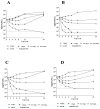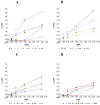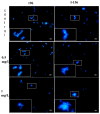Unpredictable In Vitro Killing Activity of Amphotericin B against Four Candida auris Clades
- PMID: 34451454
- PMCID: PMC8398933
- DOI: 10.3390/pathogens10080990
Unpredictable In Vitro Killing Activity of Amphotericin B against Four Candida auris Clades
Abstract
Candida auris is an emerging multiresistant yeast against which amphotericin B (AMB) is still the first therapeutic choice in certain clinical situations (i.e., meningitis, endophthalmitis, and urinary tract infections). As data about the in vitro killing activity of AMB against C. auris clades are lacking, we determined MICs, minimum fungicidal concentrations (MFCs), and killing activity of AMB against 22 isolates representing the 4 major C. auris clades (South Asian n = 6; East Asian n = 4; South African n = 6, and South American n = 6). MIC values were ≤1 mg/L regardless of clades; MFC ranges were, 1-4 mg/L, 2-4 mg/L, 2 mg/L, and 2-8 mg/L for South Asian, East Asian, South African, and South American clades, respectively. AMB showed concentration-, clade-, and isolate-dependent killing activity. AMB was fungicidal at 1 mg/L against two of six, two of four, three of six, and one of six isolates from the South Asian, East Asian, South African, and South American clades, respectively. Widefield fluorescence microscopy showed cell number decreases at 1 mg/L AMB in cases of the South Asian, East Asian, and South African clades. These data draw attention to the weak killing activity of AMB against C. auris regardless of clades, even when MICs are low (≤1 mg/L). Thus, AMB efficacy is unpredictable in treatment of invasive C. auris infections.
Keywords: Candida auris; amphotericin B; in vitro; killing rate; time–kill.
Conflict of interest statement
L. Majoros has received conference travel grants from MSD, Cidara, Astellas and Pfizer.
Figures



Similar articles
-
In Vivo Efficacy of Amphotericin B against Four Candida auris Clades.J Fungi (Basel). 2022 May 11;8(5):499. doi: 10.3390/jof8050499. J Fungi (Basel). 2022. PMID: 35628754 Free PMC article.
-
Defining Optimal Doses of Liposomal Amphotericin B Against Candida auris: Data From an In Vitro Pharmacokinetic/Pharmacodynamic Model.J Infect Dis. 2024 Feb 14;229(2):599-607. doi: 10.1093/infdis/jiad583. J Infect Dis. 2024. PMID: 38109276 Free PMC article.
-
Comparison of In Vitro Killing Activity of Rezafungin, Anidulafungin, Caspofungin, and Micafungin against Four Candida auris Clades in RPMI-1640 in the Absence and Presence of Human Serum.Microorganisms. 2021 Apr 16;9(4):863. doi: 10.3390/microorganisms9040863. Microorganisms. 2021. PMID: 33923783 Free PMC article.
-
In Vitro Killing Activities of Anidulafungin and Micafungin with and without Nikkomycin Z against Four Candida auris Clades.Pharmaceutics. 2023 Apr 29;15(5):1365. doi: 10.3390/pharmaceutics15051365. Pharmaceutics. 2023. PMID: 37242607 Free PMC article.
-
Delivery strategies of amphotericin B for invasive fungal infections.Acta Pharm Sin B. 2021 Aug;11(8):2585-2604. doi: 10.1016/j.apsb.2021.04.010. Epub 2021 Apr 29. Acta Pharm Sin B. 2021. PMID: 34522599 Free PMC article. Review.
Cited by
-
In Vivo Efficacy of Amphotericin B against Four Candida auris Clades.J Fungi (Basel). 2022 May 11;8(5):499. doi: 10.3390/jof8050499. J Fungi (Basel). 2022. PMID: 35628754 Free PMC article.
-
Defining Optimal Doses of Liposomal Amphotericin B Against Candida auris: Data From an In Vitro Pharmacokinetic/Pharmacodynamic Model.J Infect Dis. 2024 Feb 14;229(2):599-607. doi: 10.1093/infdis/jiad583. J Infect Dis. 2024. PMID: 38109276 Free PMC article.
-
Raman Imaging of Pathogenic Candida auris: Visualization of Structural Characteristics and Machine-Learning Identification.Front Microbiol. 2021 Nov 12;12:769597. doi: 10.3389/fmicb.2021.769597. eCollection 2021. Front Microbiol. 2021. PMID: 34867902 Free PMC article.
-
Chitosan-Based Hydrogels Containing Nystatin and Propolis as a Novel Tool for Candida auris Skin Decolonization.Gels. 2025 Jun 26;11(7):498. doi: 10.3390/gels11070498. Gels. 2025. PMID: 40710659 Free PMC article.
-
Efficacy of the combination of amphotericin B and echinocandins against Candida auris in vitro and in the Caenorhabditis elegans host model.Microbiol Spectr. 2024 Jan 11;12(1):e0208623. doi: 10.1128/spectrum.02086-23. Epub 2023 Nov 29. Microbiol Spectr. 2024. PMID: 38018978 Free PMC article.
References
-
- Lockhart S.R., Etienne K.A., Vallabhaneni S., Farooqi J., Chowdhary A., Govender N.P., Colombo A.L., Calvo B., Cuomo C.A., Desjardins C.A., et al. Simultaneous emergence of multidrug-resistant Candida auris on 3 continents confirmed by whole-genome sequencing and epidemiological analyses. Clin. Infect. Dis. 2017;64:134–140. doi: 10.1093/cid/ciw691. - DOI - PMC - PubMed
Grants and funding
LinkOut - more resources
Full Text Sources
Research Materials

